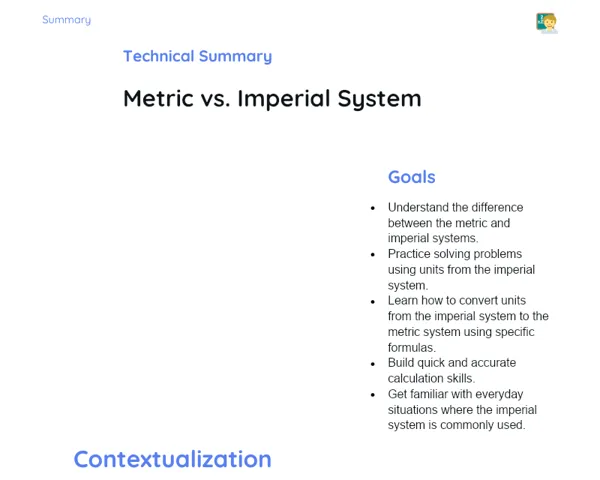Summary Tradisional | Basic Subtraction Facts
Contextualization
Subtraction is a core mathematical operation that helps us find the difference between two numbers. This operation is essential in many everyday situations – be it calculating the change after a shopping trip or figuring out how many items remain after some have been used. A clear grasp of subtraction basics paves the way for mastering more advanced math later on.
The simple facts of subtraction, such as 6-3=3, form the building blocks for all subtraction work. These basic points are important because they enable students to solve larger, more intricate problems with ease. By getting comfortable with these facts, learners build the confidence and skills necessary to tackle higher-level mathematical challenges.
To Remember!
What is subtraction
Subtraction is an arithmetic operation that helps us determine the difference between two numbers. In essence, when we subtract, we are taking one quantity away from another to see what remains. It is one of the four basic arithmetic operations, along with addition, multiplication, and division.
Subtraction is denoted by the minus sign (-). For example, in the expression 7-3, the number 7 is known as the minuend, the number 3 as the subtrahend, and the result, 4, is called the difference. Understanding these terms is key to leveraging the subtraction process correctly.
Grasping the concept that subtraction is about finding the difference between numbers is fundamental, as it helps prevent common mistakes and enables one to use subtraction appropriately in both academic and everyday contexts.
-
Subtraction determines the difference between numbers.
-
It is one of the basic arithmetic operations.
-
It is represented by the minus sign (-).
Subtraction symbol
The subtraction symbol is the minus sign (-), which instructs us to remove one number from another. For instance, in the equation 9-4, the minus sign signals that 4 should be subtracted from 9. It is important for students to recognise and understand this symbol to perform subtraction correctly.
The minus sign is widely used across many areas of mathematics and is essential for operations that involve reducing quantities. Moreover, it lays the foundation for more advanced topics like negative numbers and basic algebra.
Being familiar with the subtraction symbol is a crucial first step in learning mathematics, as it helps prevent hurdles when moving on to more complex operations.
-
The subtraction symbol is the minus sign (-).
-
It indicates that one number should be subtracted from another.
-
It is essential for mathematical operations and problem solving.
Basic facts of subtraction
The basic facts of subtraction involve straightforward differences that serve as the foundation for all subtraction-related operations. Familiarity with these facts is vital for solving more complicated problems with efficiency. For example, operations like 6-3=3, 5-2=3, and 4-1=3 are some of the basic but essential concepts.
These basics are important because they help students sharpen their mental arithmetic skills and build confidence in tackling numbers. When learners have these facts memorised, they can perform subtraction faster and with fewer errors.
Regular practice of these basic facts also enables students to identify patterns and understand numerical relationships, which is crucial for a stronger grasp of advanced mathematical ideas and daily numerical tasks.
-
They involve straightforward numerical differences.
-
They are key for solving more challenging problems.
-
They help develop mental calculation skills.
Using concrete materials
Incorporating concrete materials such as counting blocks or illustrative drawings is an effective way to teach subtraction practically. These tools allow students to visualise the subtraction process, making the concept far more accessible.
For instance, students can start with a set number of blocks, remove a few, and then count what remains. Such hands-on activities make subtraction tangible, assisting students in understanding the operation more clearly.
Furthermore, using physical materials not only makes learning enjoyable but also supports those students who might struggle with abstract numerical concepts by providing a clear, visual representation of subtraction.
-
They help in visualising the subtraction process.
-
They make the operation more concrete and easier to understand.
-
They are particularly beneficial for students who find abstract math challenging.
Key Terms
-
Subtraction: An arithmetic operation used to find the difference between two numbers.
-
Difference: The result obtained after performing a subtraction operation.
-
Minuend: The number from which another number is being subtracted.
-
Subtrahend: The number that is subtracted from the minuend.
-
Minus sign (-): The symbol used to represent subtraction.
-
Basic facts: Simple subtraction differences that form the basis for more complex subtraction operations.
Important Conclusions
In this session, we covered the basic facts of subtraction – an essential skill that helps us find the difference between numbers. We saw that subtraction is symbolised by the minus sign (-) and stands as one of the four basic arithmetic operations. We also highlighted the importance of familiarising oneself with the basic facts, such as 6-3=3, which are indispensable when it comes to solving more complex problems.
The discussion also touched upon the effective use of concrete materials like counting blocks or sketches, which make the idea of subtraction more approachable and engaging. Such methods not only help visualise the concept but also strengthen the learners' mental calculation skills. Understanding these fundamentals prepares students well for advanced mathematical challenges and everyday applications.
Knowing how to subtract properly is not just an academic exercise – it plays a vital role in daily life, be it when calculating change, measuring ingredients in a recipe, or even planning the number of steps in a game. Mastery over these basics empowers students to handle a variety of practical problems with confidence.
Study Tips
-
Practice the basic subtraction facts regularly using flashcards or educational apps to boost mental calculation abilities.
-
Use concrete materials, like blocks or sketches, to clearly visualise subtraction operations and reinforce your understanding.
-
Apply subtraction in daily scenarios – such as calculating shopping change or measuring ingredients – to see its practical relevance.



